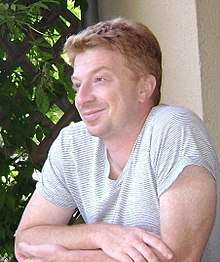Nikita Nekrasov
Nikita Alexandrovich Nekrasov (Russian: Ники́та Алекса́ндрович Некра́сов; born 10 April 1973)[1] is a mathematical and theoretical physicist at the Simons Center for Geometry and Physics and C.N.Yang Institute for Theoretical Physics at Stony Brook University in New York, [2] and a Professor of the Russian Academy of Sciences.
Nikita Nekrasov | |
|---|---|
 | |
| Born | April 10, 1973 |
| Nationality | Russian, French |
| Alma mater | |
| Scientific career | |
| Fields | Physics, Mathematics |
| Institutions |
|
Career
Nekrasov studied at the Moscow State 57th School in 1986–1989.[3] He graduated with honors from the Moscow Institute of Physics and Technology in 1995, and joined the theory division of the Institute for Theoretical and Experimental Physics. In parallel, in 1994–1996 Nekrasov did his graduate work at Princeton University, under the supervision of David Gross.[4] His Ph.D. thesis[5] on Four Dimensional Holomorphic Theories was defended in 1996.
He joined Harvard Society of Fellows at Harvard University as a Junior Fellow 1996–1999. He was then a Robert. H. Dicke Fellow at Princeton University from 1999 to 2000. In 2000 he moved to France as a permanent professor at the Institut des Hautes Études Scientifiques. Since 2013, he is a full professor at the Simons Center for Geometry and Physics [6] and C. N. Yang Institute for Theoretical Physics[7] at Stony Brook University in New York.
Research
Nekrasov is mostly known for his work on supersymmetric gauge theory, quantum integrability, and string theory. The Nekrasov partition function, which he introduced in his 2002 paper,[8] relates in an intricate way the instantons in gauge theory, integrable systems, and representation theory of infinite-dimensional algebras.
Honours and awards
For his discovery of noncommutative instantons together with Albert Schwarz in 1998[9], noncommutative monopoles and monopole strings with David Gross in 2000 and for his work with Alexander S. Gorsky on the relations between gauge theories and many-body systems he was awarded the Grand Prix Jacques Herbrand of the French Academy of Sciences in 2004. For his contributions to topological string theory and the ADHM construction he received the Hermann Weyl Prize in 2004. In 2008 together with Davesh Maulik, Andrei Okounkov and Rahul Pandharipande he formulated a set of conjectures relating Gromov–Witten theory and Donaldson–Thomas theory, for which the four authors were awarded the Compositio Prize in 2009.
References
- Who's Who in France. 2004.
- "Stony Brook Physics & Astronomy: $group".
- "Nekrasov's CV at the IHES". Retrieved 6 September 2010.
- Nikita Nekrasov at the Mathematics Genealogy Project
- "Nikita Nekrasov's PhD. thesis" (PDF).
- "Nekrasov's CV at the SCGP". Retrieved 2 July 2020.
- "People at the YITP". Retrieved 2 July 2020.
- Nekrasov, Nikita A. (2004). "Seiberg-Witten prepotential from instanton calculus". Advances in Theoretical and Mathematical Physics. 7: 831–864. arXiv:hep-th/0206161. Bibcode:2002hep.th....6161N. doi:10.4310/ATMP.2003.v7.n5.a4.
- Nekrasov, Nikita; Schwarz, Albert (1998). "Instantons on noncommutative and superconformal six-dimensional theory". Commun. Math. Phys. 198: 689--703. arXiv:hep-th/9802068. doi:10.1007/s002200050490.